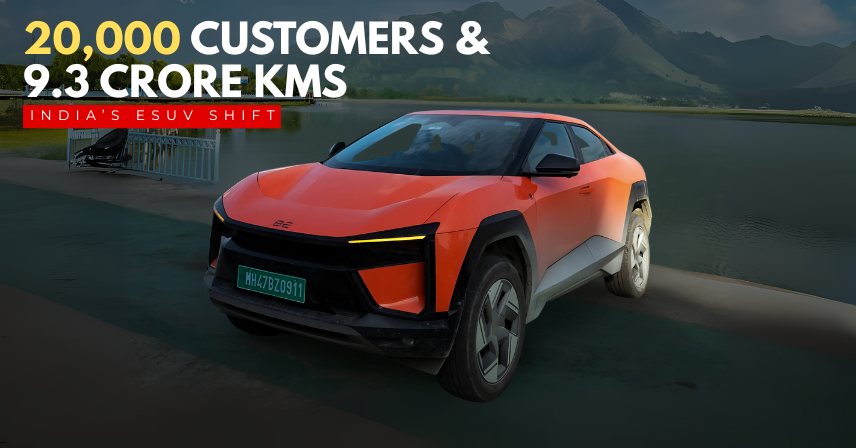The Indian automobile industry is undergoing a historic shift. What once seemed like a distant future is now becoming reality — electric vehicles, especially SUVs, are entering the mainstream. With 20,000 customers already on the road and a combined distance of 9.3 crore kilometers driven, two eSUVs have emerged as frontrunners in shaping India’s green mobility future.
This milestone is not just about numbers. It reflects growing customer trust, stronger charging infrastructure, better performance, and government-backed incentives that are driving the adoption of electric SUVs in India.
In this blog, we’ll explore:
- The rise of electric SUVs in India
- The two game-changing eSUVs behind these record numbers
- Performance, range, and ownership experience
- Challenges and opportunities in the EV sector
What this means for India’s automotive future
The Rise of Electric SUVs in India
Over the last five years, India has witnessed a surge in EV adoption, driven by government policies like FAME II subsidies, reduced GST on EVs, and state-level incentives. While electric two-wheelers dominated the initial phase, the demand for electric SUVs is now rapidly increasing.
Reasons behind this growth include:
- Affordability – More competitive pricing compared to petrol/diesel SUVs.
- Better Range – Many new eSUVs now offer 300–500 km on a single charge.
- Charging Infrastructure – Rapid expansion of fast-charging stations.
- Customer Awareness – Shift towards eco-friendly and cost-efficient mobility.
The Two eSUVs Behind the Milestone
1. Tata Nexon EV – The People’s Choice
The Tata Nexon EV has been one of India’s most successful electric SUVs. With its stylish design, practical range, and strong after-sales support, it has become the go-to EV for urban and semi-urban buyers.
Key Highlights:
- Over 15,000+ customers onboard.
- Average real-world range: 300–325 km.
- Proven track record across diverse Indian terrains.
- Supported by Tata Power’s growing charging network.
2. MG ZS EV – The Premium Urban SUV
The MG ZS EV is another key player, appealing to buyers who want premium features and international build quality. Positioned slightly above the Nexon EV, the ZS EV has carved its space in metros and Tier-1 cities.
Key Highlights:
- Over 5,000+ customers.
- Long range of 400–450 km per charge.
- Loaded with connected car technology and luxury features.
Strong customer satisfaction ratings in performance and comfort.
20,000 Customers and 9.3 Crore Kilometers – What It Means
The combined achievement of 20,000 customers and 9.3 crore kms driven is a game-changer for the EV market in India. It shows that:
- Reliability – EVs can handle long-term, high-mileage usage.
- Customer Trust – More Indians are confident about shifting to EVs.
- Market Acceptance – eSUVs are no longer niche; they’re going mainstream.
This also highlights how these two SUVs have paved the way for future models, encouraging more automakers like Hyundai, Mahindra, and BYD to expand their eSUV lineup in India.
Ownership Experience – What Customers Are Saying
- Cost Savings: EV owners report 70–80% lower running costs compared to petrol/diesel SUVs.
- Low Maintenance: Fewer moving parts mean reduced service costs.
- Charging Ease: With home charging solutions and an expanding fast-charger network, customers face fewer range concerns.
- Driving Pleasure: Instant torque delivery makes eSUVs exciting to drive, especially in city traffic.
Challenges Facing India’s eSUV Market
While the numbers are impressive, the road ahead is not without challenges:
- Charging Infrastructure Gaps – Rural and semi-urban areas still lack adequate coverage.
- High Initial Cost – Despite subsidies, eSUVs are priced higher than ICE alternatives.
- Battery Concerns – Customers still worry about long-term battery degradation and replacement costs.
- Awareness – Many customers remain unaware of EV financing and subsidy options.
Future of eSUVs in India
With companies like Tata, MG, Hyundai, and Mahindra investing heavily in EVs, the future looks electric. Upcoming models such as the Mahindra XUV.e8 and Hyundai’s Creta EV promise to expand choices for customers.
Experts predict that by 2030, 30–40% of new car sales in India could be electric, with SUVs leading the way.
Conclusion
The milestone of 20,000 customers and 9.3 crore kms driven by two eSUVs is a turning point for India’s EV journey. It proves that electric SUVs are not just futuristic experiments but mainstream mobility solutions for today’s India.
As infrastructure improves, prices stabilize, and awareness spreads, the adoption of eSUVs will only accelerate. This is the beginning of a new chapter in India’s automotive history — one that is green, sustainable, and future-ready.
For more updates like this, visit www.carbikebhp.com

